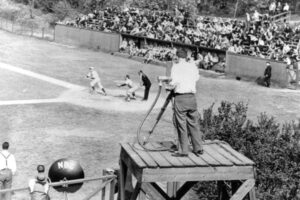Miscellaneous Technology
VHS Introduced to America
 June 4, 1977
June 4, 1977
The VHS videocassette format is introduced as Vidstar in North America at a press conference before the Consumer Electronics Show starts in Chicago. VHS, or Video Home System, was based on an open standard developed by JVC in 1976. As compared to the Sony Betamax format it would compete against, VHS allowed longer playtime, faster rewinding, and fast-forwarding.
Would You Like to Play a Game?
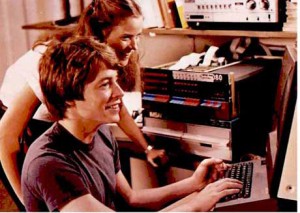 June 3, 1983
June 3, 1983
The science fiction film WarGames is released. Notable for bringing the hacking phenomena to the attention of the American public, it ignites a media sensation regarding the hacker sub-culture. The film’s NORAD set is the most expensive ever built at the time at a cost of $1 million dollars. Not widely known is that the movie studio provided the film’s star, Matthew Broderick, with the arcade games Galaga and Galaxian so he could get first-hand experience before shooting the film’s arcade scenes.
First Automobile Accident
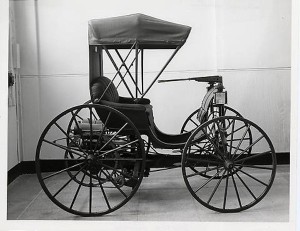 May 30, 1896
May 30, 1896
The first auto accident on record occurs in New York City when a Duryea Motor Wagon driven by Henry Wells collides with a bicycle ridden by Evylyn Thomas. New Yorkers probably accused Henry of being from Jersey, but he was actually from Massachusetts.
First Modern Color Movie
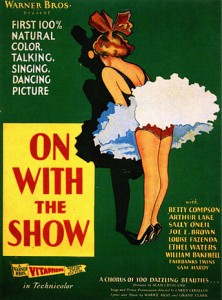 May 28, 1929
May 28, 1929
The Warner Brothers’ film On With the Show, the first talking movie that is all in color, debuts at New York City’s Winter Garden theater. The film uses two-color Technicolor and Vitaphone sound.
Return of the Jedi
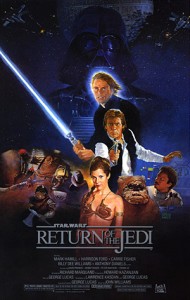 May 25, 1983
May 25, 1983
The third installment in the original Star Wars trilogy, Return of the Jedi, is released six years to the day after the first Star Wars movie. Return of the Jedi continued to raise the bar in special effects technology that its predecessors set. The film’s final space battle, for example, was of a size and scale unprecedented at the time.
A Long Time Ago in a Galaxy Far, Far Away …
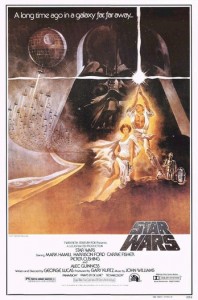 May 25, 1977
May 25, 1977
The motion picture Star Wars is released in thirty-two US theaters. The film will immediately break records unlike any before it, essentially becoming the first blockbuster in history. The film’s unprecedented use of special effects sparked a revolution of movies using technology-based visual effects. Perhaps the film’s greatest contribution to technology was the creation two years earlier of the company Industrial Light and Magic, which is still the leading special effects house in the industry.
First Night Baseball Game
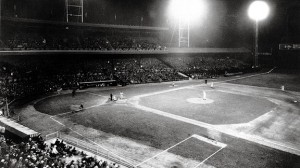 May 24, 1935
May 24, 1935
The first night major league baseball game is played in Cincinnati. The hometown Reds defeated the visiting Philadelphia Phillies 2-1. Night baseball caught on around the league very quickly – except for the Chicago Cubs, who didn’t play a home night game until 1988. Why am I not surprised?
The Wright Patent
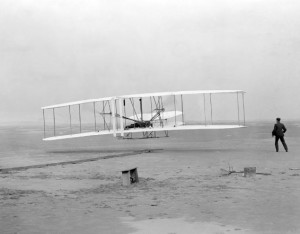 May 22, 1906
May 22, 1906
Orville and Wilbur Wright are granted the first airplane patent in the U.S. for their “new and useful improvements in Flying Machines.” (US No. 821,393)
The Empire Strikes Back
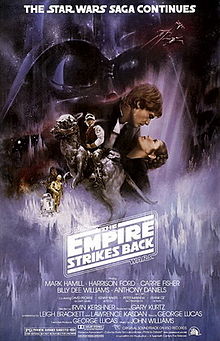 May 21, 1980
May 21, 1980
The sequel to the the smash success Star Wars, The Empire Strikes Back is released on this day, almost exactly 3 years after the release of the original film. The pioneering use of special effects technology in the Star Wars Trilogy transformed the movie industry.
First Sports TV Broadcast
NBC carries the first broadcast televised sporting event in history, the second game of a doubleheader baseball game between Columbia and Princeton. Only about 400 TV sets were capable of receiving the transmission, but it was an important first step in the history of televised sports. NBC would later broadcast a major league baseball game in August of that year, a college football game in September, closely followed by an NFL game in October.
Previously Germany had televised parts of the 1936 Olympic games, but TV sets were not available for sale in Germany at the time. Therefore viewing was limited to a number of “public viewing rooms” in Berlin and Potsdam.

